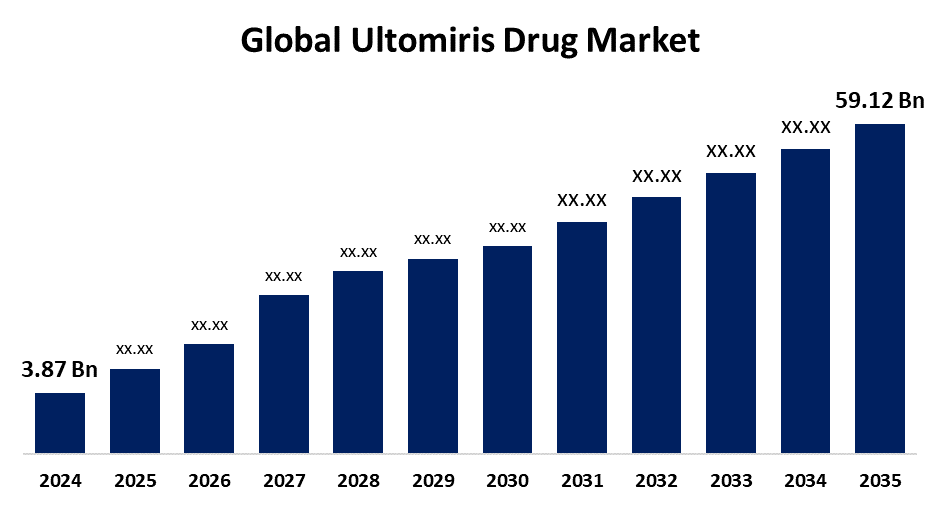Global Ultomiris Drug Market Size, Share, and COVID-19 Impact Analysis, By Indication (Paroxysmal Nocturnal Hemoglobinuria, Atypical Hemolytic Uremic Syndrome, Generalized Myasthenia Gravis, and Neuromyelitis Optica Spectrum Disorder), By Distribution Channel (Hospital Pharmacies, Retail Pharmacies, and Online Pharmacies), By End Use (Adult and Pediatric), and By Region (North America, Europe, Asia-Pacific, Latin America, Middle East, and Africa), Analysis and Forecast 2025 - 2035.
Industry: HealthcareGlobal Ultomiris Drug Market Insights Forecasts to 2035
- The Global Ultomiris Drug Market Size Was Estimated at USD 3.87 Billion in 2024
- The Market Size is Expected to Grow at a CAGR of around 28.13% from 2025 to 2035
- The Worldwide Ultomiris Drug Market Size is Expected to Reach USD 59.12 Billion by 2035
- Asia Pacific is expected to Grow the fastest during the forecast period.

Get more details on this report -
The Global Ultomiris Drug Market Size was worth around USD 3.87 Billion in 2024 and is predicted to Grow to around USD 59.12 Billion by 2035 with a compound annual growth rate (CAGR) of 28.13% from 2025 to 2035. The market growth is boosted by Ultomiris’s extended dosing and expanding indications in neurology and autoimmune diseases drive strong patient adherence and demand. Backed by AstraZeneca’s strategic pipeline and marketing efforts, it is positioned for sustained market growth and long-term success.
Market Overview
The ultomiris drug market refers to the long-acting humanized monoclonal antibody that helps stop immune-mediated cell damage by blocking the complement protein C5. It is approved to treat rare complement-driven disorders, such as neuromyelitis optica spectrum disorder (NMOSD), atypical hemolytic uremic syndrome (aHUS), generalized myasthenia gravis (gMG), and paroxysmal nocturnal hemoglobinuria (PNH). It is given intravenously every 4 to 8 weeks.
The Ultomiris has a longer dose interval than Soliris, it has improved patient compliance and is gaining significant market traction. Its clinical acceptance is highlighted by the high transition rates among PNH and aHUS patients. Its market presence is further strengthened by its expansion into new indications, including gMG and possible clearance for NMOSD. Continued demand is supported by the rising prevalence of uncommon autoimmune and hematologic disorders. New criteria and improved diagnostics are making it possible to identify suitable people early. These elements, along with AstraZeneca and Alexion's strategic initiatives, guarantee consistent revenue growth through 2035.
Report Coverage
This research report categorizes the ultomiris drug market based on various segments and regions, forecasts revenue growth, and analyzes trends in each submarket. The report analyses the key growth drivers, opportunities, and challenges influencing the ultomiris drug market. Recent market developments and competitive strategies such as expansion, type launch, development, partnership, merger, and acquisition have been included to draw the competitive landscape in the market. The report strategically identifies and profiles the key market players and analyses their core competencies in each sub-segment of the ultomiris drug market.
Global Ultomiris Drug Market Report Coverage
| Report Coverage | Details |
|---|---|
| Base Year: | 2024 |
| Market Size in 2024: | USD 3.87 Billion |
| Forecast Period: | 2025-2035 |
| Forecast Period CAGR 2025-2035 : | 28.13% |
| 2035 Value Projection: | USD 59.12 Billion |
| Historical Data for: | 2020-2023 |
| No. of Pages: | 203 |
| Tables, Charts & Figures: | 100 |
| Segments covered: | By Indication, By Distribution Channel, By End Use and By Region |
| Companies covered:: | AstraZeneca, Xencor, Inc., Chugai Pharmaceutical, Argenx, and Others |
| Pitfalls & Challenges: | COVID-19 Impact, Challenges, Future, Growth, & Analysis |
Get more details on this report -
Driving Factors
The market is driven by the prolonged dosage regimen, which promotes patient adherence and widespread use of Soliris in key indications such as aHUS and PNH. Its therapeutic footprint is further expanded by its expanding use in neurology, including the treatment of gMG and possible NMOSD. Demand is being driven by clever marketing initiatives and an increase in the diagnosis of uncommon autoimmune disorders. Strong pipeline momentum is shown by ongoing trials in IgA nephropathy, CSA-AKI, and HSCT-TMA. The goal of AstraZeneca's approach is to present Ultomiris as a flexible remedy for a variety of complement-driven illnesses. All of these elements work together to promote strong market expansion and sustained business success.
Restraining Factors
The market growth is hindered by the high expense of medical care, and access to patients may be restricted as a result, particularly in low- and middle-income areas. Despite the therapeutic benefits of the medicine, the financial limitations and payment limits imposed on healthcare systems provide considerable challenges. The increasing competition in this field is another significant obstacle to treating rare diseases.
Market Segmentation
The ultomiris drug market share is classified into indication, distribution channel, and end use.
- The paroxysmal nocturnal hemoglobinuria segment held the largest share in 2024 and is anticipated to grow at a significant CAGR during the forecast period.
Based on the indication, the ultomiris drug market is classified into paroxysmal nocturnal hemoglobinuria, atypical hemolytic uremic syndrome, generalized myasthenia gravis, and neuromyelitis optica spectrum disorder. Among these, the paroxysmal nocturnal hemoglobinuria segment held the largest share in 2024 and is anticipated to grow at a significant CAGR during the forecast period. The segmental growth can be attributed to its long dose schedule and its ability to lessen hemolysis. Its quick adoption, especially in Europe, has been fueled by increased patient compliance and physician preference. Its status as a frontline therapy is supported by improved diagnostics and positive results. Its quality-of-life advantages and long-term safety support the ongoing need for therapy.
- The hospital pharmacies segment dominated the market in 2024 and is projected to grow at a substantial CAGR during the forecast period.
Based on the distribution channel, the ultomiris drug market is divided into hospital pharmacies, retail pharmacies, and online pharmacies. Among these, the hospital pharmacies segment dominated the market in 2024 and is projected to grow at a substantial CAGR during the forecast period. The growth is driven by Ultomiris's hospital-based infusion methodology and regulated administration guarantees reliable and secure therapy delivery. Close observation and adherence to dosage schedules are made possible by controlled surroundings. Coordinated clinical teams and skilled hospital pharmacists improve patient care. Growing institutional usage is reflected in the expansion of infusion units in important hospitals such as Charite Berlin.
- The adult segment held the largest share in 2024 and is anticipated to grow at a significant CAGR during the forecast period.
Based on the end use, the ultomiris drug market is classified into adult and pediatric. Among these, the adult segment held the largest share in 2024 and is anticipated to grow at a significant CAGR during the forecast period. The segmental growth can be attributed to the adult population because of the significant illness burden and steady treatment eligibility for disorders, including gMG and PNH. Clinical results and adherence are improved by its long-acting profile and lower infusion frequency. Access to specialized centers and increased adult trial participation support revenue growth even more.
Regional Segment Analysis of the Ultomiris Drug Market
- North America (U.S., Canada, Mexico)
- Europe (Germany, France, U.K., Italy, Spain, Rest of Europe)
- Asia-Pacific (China, Japan, India, Rest of APAC)
- South America (Brazil and the Rest of South America)
- The Middle East and Africa (UAE, South Africa, Rest of MEA)
North America is anticipated to hold the largest share of the ultomiris drug market over the predicted timeframe.

Get more details on this report -
North America is anticipated to hold the largest share of the ultomiris drug market over the predicted timeframe. The regional growth can be attributed to its sophisticated healthcare system and high incidence of uncommon disorders. Adoption is fueled by early diagnosis and high demand for neurology treatments like gMG and NMOSD. Dosing convenience is driving the acceleration of the switch from Soliris to Ultomiris. The region's strong position is further strengthened by ongoing clinical studies and innovation adoption.
Asia Pacific is expected to grow at a rapid CAGR in the ultomiris drug market during the forecast period. The region's growth is being driven by an increasing number of patients suffering from uncommon illnesses. Access to cutting-edge tests and treatments can be improved by improving the healthcare infrastructure. Early diagnosis and intervention are made easier by greater knowledge and instruction regarding uncommon illnesses. Ultomiris adoption is aided by the region's emphasis on implementing cutting-edge treatments. Partnerships and collaborations in the healthcare industry support market growth. Due to these factors, ultomiris's market in Asia Pacific is expanding quickly.
Competitive Analysis:
The report offers the appropriate analysis of the key organizations/companies involved within the ultomiris drug market, along with a comparative evaluation primarily based on their type of offering, business overviews, geographic presence, enterprise strategies, segment market share, and SWOT analysis. The report also provides an elaborative analysis focusing on the current news and developments of the companies, which includes type development, innovations, joint ventures, partnerships, mergers & acquisitions, strategic alliances, and others. This allows for the evaluation of the overall competition within the market.
- AstraZeneca
- Xencor, Inc.
- Chugai Pharmaceutical
- Argenx
- Others.
Key Target Audience
- Market Players
- Investors
- End-users
- Government Authorities
- Consulting And Research Firm
- Venture capitalists
- Value-Added Resellers (VARs)
Recent Development
- In March 2024, Ultomiris was cleared by the FDA in the United States for the treatment of people with AQP4 antibody-positive NMOSD. This approval was based on positive results from the CHAMPION-NMOSD Phase III trial, which found no relapses in patients treated with Ultomiris.
Market Segment
This study forecasts revenue at global, regional, and country levels from 2020 to 2035. Spherical Insights has segmented the ultomiris drug market based on the below-mentioned segments:
Global Ultomiris Drug Market, By Indication
- Paroxysmal Nocturnal Hemoglobinuria
- Atypical Hemolytic Uremic Syndrome
- Generalized Myasthenia Gravis
- Neuromyelitis Optica Spectrum Disorder
Global Ultomiris Drug Market, By Distribution Channel
- Hospital Pharmacies
- Retail Pharmacies
- Online Pharmacies
Global Ultomiris Drug Market, By End Use
- Adult
- Pediatric
Global Ultomiris Drug Market, By Regional Analysis
- North America
- US
- Canada
- Mexico
- Europe
- Germany
- UK
- France
- Italy
- Spain
- Russia
- Rest of Europe
- Asia Pacific
- China
- Japan
- India
- South Korea
- Australia
- Rest of Asia Pacific
- South America
- Brazil
- Argentina
- Rest of South America
- Middle East & Africa
- UAE
- Saudi Arabia
- Qatar
- South Africa
- Rest of the Middle East & Africa
Frequently Asked Questions (FAQ)
-
1. What is the CAGR of the ultomiris drug market over the forecast period?The global ultomiris drug market is projected to expand at a CAGR of 28.13% during the forecast period.
-
2. What is the market size of the ultomiris drug market?The global ultomiris drug market size is expected to grow from USD 3.87 Billion in 2024 to USD 59.12 Billion by 2035, at a CAGR of 28.13% during the forecast period 2025-2035.
-
3. Which region holds the largest share of the ultomiris drug market?North America is anticipated to hold the largest share of the ultomiris drug market over the predicted timeframe.
Need help to buy this report?